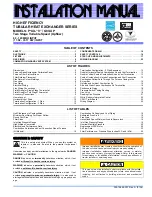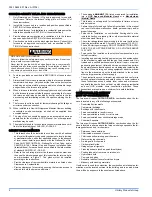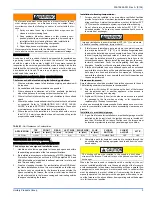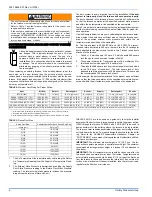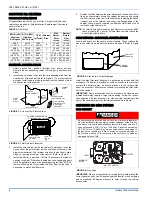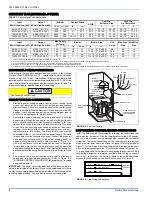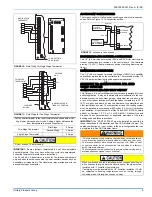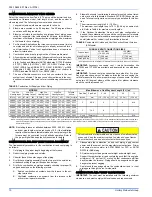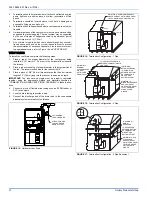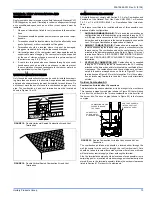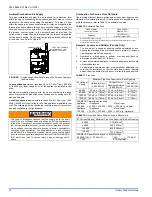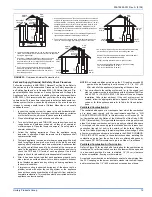
035-19624-001 Rev. A (0104)
Unitary Products Group
15
Vent and Supply (Outside) Air Safety Check Procedure
Follow the procedure in ANSI Z223.1 National Fuel Gas Code. Refer to
the section on the “Recommended Procedure for Safety Inspection of
an Existing Appliance” or in Canada B149.1-00 Natural Gas and Pro-
pane Installation Code section on “Venting Systems and Air Supply for
Appliances” and all local codes. In addition to the procedure specified in
ANSI Z223.1, York recommends that you follow the venting safety pro-
cedure below. This procedure is designed to detect an inadequate ven-
tilation system that can cause the appliances in the area to operate
improperly causing unsafe levels of Carbon Monoxide or an unsafe
condition to occur.
1.
Inspect the venting system for proper size and horizontal pitch.
Determine that there is no blockage, restriction, leakage, corrosion
or other deficiencies, which could cause an unsafe condition
2.
Close all building doors and windows and all doors.
3.
Turn on clothes dryers and TURN ON any exhaust fans, such as
range hoods and bathroom exhausts, so they shall operate at
maximum speed. Open the fireplace dampers. Do not operate a
summer exhaust fan.
4.
Follow the lighting instructions. Place the appliance being
inspected in operation. Adjust thermostat so the appliance shall
operate continuously.
5.
Test each appliance (such as a water heater) equipped with a draft
hood for spillage (down-draft or no draft) at the draft hood relief
opening after 5 minutes of main burner operation. Appliances that
do not have draft hoods need to be checked at the vent pipe as
close to the appliance as possible. Use a combustion analyzer to
check the CO2 and CO levels of each appliance. Use a draft
gauge to check for a downdraft or inadequate draft condition.
6.
After it has been determined that each appliance properly vents
when tested as outlined above, return doors, windows, exhaust
fans, fireplace dampers and any other gas burning appliance to
their normal condition.
7.
If improper venting is observed during any of the above tests, a
problem exists with either the venting system or the appliance
does not have enough combustion air (Supply Air from outside) to
complete combustion. This condition must be corrected before the
appliance can function safely.
NOTE:
An unsafe condition exists when the CO reading exceeds 40
ppm and the draft reading is not in excess of - 0.1 in. W.C. (-25
kPa) with all of the appliance(s) operating at the same time.
8.
Any corrections to the venting system and / or to the supply (out-
side) air system must be in accordance with the National Fuel Gas
Code Z223.1 or CAN/CGA B149.1-00 Natural Gas and Propane
Installation Code (latest editions). If the vent system must be
resized, follow the appropriate tables in Appendix G of the above
codes or for this appliance and refer to Table 9 of these instruc-
tions.
Ventilated Combustion Air
The ventilated attic space or a crawl space from which the combustion
air is taken must comply with the requirements specified in “AIR
SOURCE FROM OUTDOORS” in this instruction or in Section 5.3, Air
for Combustion and Ventilation of the National Fuel Gas Code, ANSI
Z223.1 (latest edition). This type installation requires two properly sized
pipes. One brings combustion air from a properly ventilated attic space
or crawl space and a second pipe that extends from the furnace vent
connection (top right of unit) to the exterior of the building. Refer to
Table 9 for intake pipe sizing, allowable length and elbow usage. Follow
all notes, procedures and required materials in the SEALED COMBUS-
TION AIR SUPPLY section in these instructions when installing the
combustion air pipe from the unit and into a ventilated attic space or
crawl space. DO NOT terminate vent pipe in an Attic or Crawl Space.
Ventilated Combustion Air Termination
Refer to Figure 23 for required attic termination for the combustion air
intake pipe. For attic termination, use two 90 elbows with the open end
in a downward position. Be sure to maintain 12” (30 cm) clearance
above any insulation, flooring or other material.
A crawl space combustion air installation consists of a straight pipe from
the PVC coupling on the burner box that extends into the crawl space
and terminates with a 1/4” (6.35 mm) mesh screen and no elbows.
FIGURE 22:
Outside and Ambient Combustion Air
VENTILATED
SOFFIT
GAS
VENTILATED
CRAWL SPACE
OUTLET
AIR (a)
GABLE
VENT
FURNACE
GAS
HEATER
WATER
GAS
SOFFIT
FURNACE
GAS
HEATER
WATER
OUTLET
AIR (a)
VENTILATED
GABLE
VENT
TOP ABOVE
INSULATION
TOP ABOVE
INSULATION
INLET
AIR (b)
INLET
AIR (a)
GAS
OUTLET
AIR (b)
INLET
AIR (a)
INLET
AIR (b)
VENT
VENT
VENT
VENT
VENT
FURNACE
GAS
HEATER
WATER
An opening may be used in lieu of a duct to provide the outside air
supply to an appliance unless otherwise permitted by the authority
having jurisdiction. The opening shall be located within 12” (30 cm)
horizontally from, the burner level of the appliance. Refer to “AIR
SOURCE FROM OUTDOORS AND VENT AND SUPPLY AIR
SAFETY CHECK” in these instructions for additional information
and safety check procedure.
1.
The duct shall be either metal, or a material meeting the class I
requirements of CAN4-S110 Standard for Air Ducts.
2.
The duct shall be at least the same cross-sectional area as the
free area of the air supply inlet opening to which it connects.
3.
The duct shall terminate within 12” (30 cm) above, and within 24”
(609.6 mm) horizontally from, the burner level of the appliance
having the largest input.
4.
A square or rectangular shaped duct shall only be used
when the required free area of the supply opening is
9 square inches (58 cm²) or larger, when used its small
dimension shall not be less than 3” (76 mm).
5.
An air inlet supply from outdoors shall be equipped with
a means to prevent the direct entry of rain and wind.
Such means shall not reduce the required free area of
An air supply inlet opening from the outdoors shall be located
not less than 12” (30 cm) above the outside grade level.
6.
7.
OPTIONAL
INLET AIR (a)
the air supply opening.
Minimum One Inlet and One Outlet Supply is Required and it
may be in the Combination Shown below
Inlet Air Opening Must be Within 12” (30 cm) of floor
Outlet Air Opening Must be Within 12” (30 cm) of ceiling
(a) 1 In
2
per 4000 BTUH (1.17 kW)
(b) 1 In
2
per 2000 BTUH (0.59 kW)
ATTIC
ATTIC

